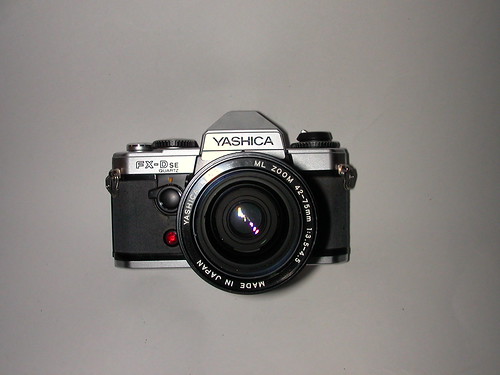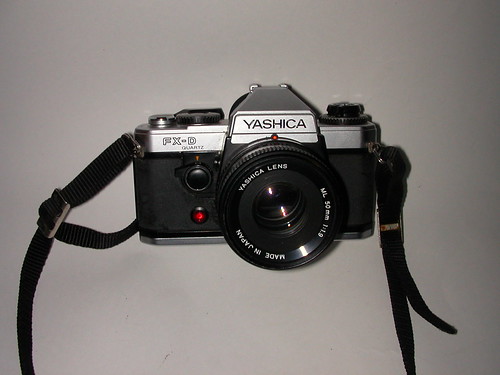Difference between revisions of "Yashica FX-D"
Hanskerensky (talk | contribs) (Added link to review) |
|||
| (22 intermediate revisions by 11 users not shown) | |||
| Line 1: | Line 1: | ||
| − | The Yashica FX-D is " The little sister" of Contax 139 Quartz. Still, some people consider Contax to have a more solid feel | + | __NOTOC__ |
| + | {|align=right | ||
| + | | | ||
| + | {{Flickr_image | ||
| + | |image_source= http://www.flickr.com/photos/rst90274/265975683/in/pool-camerawiki/ | ||
| + | |image= http://farm1.staticflickr.com/122/265975683_cc247ecaf0.jpg | ||
| + | |image_align= | ||
| + | |image_text= FX-D SE Quartz | ||
| + | |image_by= rst12 | ||
| + | |image_rights= with permission | ||
| + | }} | ||
| + | |- | ||
| + | || | ||
| + | {{Flickr_image | ||
| + | |image_source= http://www.flickr.com/photos/rst90274/265975903/in/pool-camerawiki/ | ||
| + | |image= http://farm1.static.flickr.com/120/265975903_cd8a931489.jpg | ||
| + | |image_align= | ||
| + | |image_text= FX-D Quartz chrome | ||
| + | |image_by= rst12 | ||
| + | |image_rights= with permission | ||
| + | }} | ||
| + | |} | ||
| + | The '''[[Yashica]] FX-D''' is " The little sister" of the [[Contax 139Q|Contax 139 Quartz]] released in 1980. Still, some people consider Contax to have a more solid feel, plus it adds [[TTL]] flash, [[Depth of field|DOF]] preview, and aperture readout in the viewfinder among other differences. Otherwise the FX-D has similar features, the same rather small housing, and the same [[Contax/Yashica lenses|Contax/Yashica bayonet lens]] mount. The FX-D is well suited as second body for Contax users, since the controls are placed in Contax-like positions on the body. In particular you find the [[meter]] control button on the front side. The bottom of the camera contain contact for a motor drive. Upon release one was not available, but it was compatible with the Contax 139 motor drive. | ||
| − | + | A variation of the FX-D was sold as the '''FX-D SE Quartz'''. This version of the camera features a back-plate with a window behind which is a rotating red&white wheel which indicates that the film is being wound-on. This does not exist on the standard FX-D. Yashica added a single page insert into the FX-D user manual to explain the difference as well as a sticker to the front cover showing 'SE'. It was often sold with a FX motor drive winder and a zoom lens. | |
| − | |||
| − | + | ===Issues=== | |
| − | + | One of the main problems with the FX-D is the spongy soft vinyl material used for the covering the camera. It becomes very fragile quickly, making it easy to separate and peel. | |
| − | + | ==Specifications== | |
| − | ( | + | * Type: 35mm SLR with aperture preferred automatic exposure. |
| + | * Image size: 24 x 36 mm | ||
| + | * Lens mount: Contax/Yashica bayonet mount. | ||
| + | * Shutter: Electronic vertical running metal focal plane shutter. | ||
| + | * Shutter speeds: Quartz-timed electronic shutter with variable speeds on AUTO from 1/1000 to 1 seconds. Manual from 1/1000 to 1 sec., plus X (1/100 sec.) and "B" Sync speed of 1/100 sec. | ||
| + | * Exposure control: TTL, center-weighted at full aperture. Aperture-preferred automatic exposure. | ||
| + | * Meter: SPD Silicon Photo Diode | ||
| + | * Measuring range: EV 1 to EV 18 sensitivity range at ASA 100 with f/1.4 lens. ASA range 25-1600. | ||
| + | * Shutter release: Electromagnetic release system; auxiliary remote release via "Release socket". | ||
| + | * Exposure compensation: + 2 EV | ||
| + | * Viewfinder: Fixed eye-level pentaprism type; field of view 95%; 0.86 magnification (with 50 mm lens) | ||
| + | * Viewfinder display: Shutter speeds indicated by 16 LEDs. | ||
| + | * Focusing screen: Horizontal split-image spot, with microprism collar and matte field. | ||
| + | * Film advance: With rapid advance lever; 130° setting angle; 20° standoff position. | ||
| + | * Self-timer: Electronic self-timer with 10 sec. delay. | ||
| + | * Power: 2x 1.55 V silver-oxide batteries SR44 or alkaline LR44. Battery check. | ||
| + | * Dimensions: 135 x 86 x 50 mm | ||
| + | * Weight: 460g | ||
| − | + | ==Links== | |
| − | + | * [http://www.butkus.org/chinon/yashica/yashica_fx-d/yashica_fx-d.htm Yashica FX-D user manual] at [http://www.orphancameras.com Mike Butkus' OrphanCameras] | |
| + | *[https://davidde.com/2022/02/27/review-the-yashica-fx-d/ Yashica FX-D review] at [https://davidde.com/ Davidde.com] | ||
| − | + | [[Category:F|FX-D Yashica]] | |
| − | + | [[Category:Japanese 35mm SLR]] | |
| − | + | [[Category:Yashica|FX-D]] | |
| − | + | [[Category:Contax/Yashica mount]] | |
| − | + | [[Category:1980]] | |
| − | |||
| − | |||
| − | |||
| − | |||
| − | |||
| − | |||
| − | |||
| − | |||
| − | |||
| − | |||
| − | |||
| − | |||
| − | |||
| − | |||
| − | |||
| − | |||
| − | |||
| − | |||
| − | |||
| − | |||
| − | |||
| − | |||
| − | |||
| − | |||
| − | |||
| − | |||
| − | |||
| − | |||
| − | |||
| − | |||
| − | |||
| − | |||
| − | |||
| − | |||
| − | |||
| − | |||
| − | |||
| − | |||
| − | |||
| − | |||
Latest revision as of 05:58, 10 November 2023
| ||
|
The Yashica FX-D is " The little sister" of the Contax 139 Quartz released in 1980. Still, some people consider Contax to have a more solid feel, plus it adds TTL flash, DOF preview, and aperture readout in the viewfinder among other differences. Otherwise the FX-D has similar features, the same rather small housing, and the same Contax/Yashica bayonet lens mount. The FX-D is well suited as second body for Contax users, since the controls are placed in Contax-like positions on the body. In particular you find the meter control button on the front side. The bottom of the camera contain contact for a motor drive. Upon release one was not available, but it was compatible with the Contax 139 motor drive.
A variation of the FX-D was sold as the FX-D SE Quartz. This version of the camera features a back-plate with a window behind which is a rotating red&white wheel which indicates that the film is being wound-on. This does not exist on the standard FX-D. Yashica added a single page insert into the FX-D user manual to explain the difference as well as a sticker to the front cover showing 'SE'. It was often sold with a FX motor drive winder and a zoom lens.
Issues
One of the main problems with the FX-D is the spongy soft vinyl material used for the covering the camera. It becomes very fragile quickly, making it easy to separate and peel.
Specifications
- Type: 35mm SLR with aperture preferred automatic exposure.
- Image size: 24 x 36 mm
- Lens mount: Contax/Yashica bayonet mount.
- Shutter: Electronic vertical running metal focal plane shutter.
- Shutter speeds: Quartz-timed electronic shutter with variable speeds on AUTO from 1/1000 to 1 seconds. Manual from 1/1000 to 1 sec., plus X (1/100 sec.) and "B" Sync speed of 1/100 sec.
- Exposure control: TTL, center-weighted at full aperture. Aperture-preferred automatic exposure.
- Meter: SPD Silicon Photo Diode
- Measuring range: EV 1 to EV 18 sensitivity range at ASA 100 with f/1.4 lens. ASA range 25-1600.
- Shutter release: Electromagnetic release system; auxiliary remote release via "Release socket".
- Exposure compensation: + 2 EV
- Viewfinder: Fixed eye-level pentaprism type; field of view 95%; 0.86 magnification (with 50 mm lens)
- Viewfinder display: Shutter speeds indicated by 16 LEDs.
- Focusing screen: Horizontal split-image spot, with microprism collar and matte field.
- Film advance: With rapid advance lever; 130° setting angle; 20° standoff position.
- Self-timer: Electronic self-timer with 10 sec. delay.
- Power: 2x 1.55 V silver-oxide batteries SR44 or alkaline LR44. Battery check.
- Dimensions: 135 x 86 x 50 mm
- Weight: 460g

